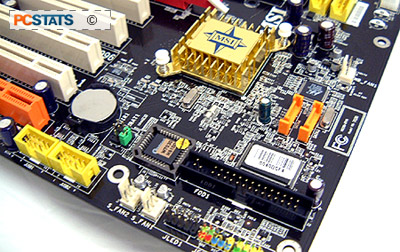MSI K8N Neo-FIS2R Platinum NF3-250Gb Motherboard Review
When
AMD integrated a memory controller into the Athlon64 processor, they took away
one of the key performance features that differentiates one chipset from another. That's why,
when you read through Athlon64 motherboard reviews, no matter what the chipset is, the
platforms always performs about the same. Of course,
that's not necessarily a bad thing. After all, this guarantees that AMDs
Athlon64 will maintain
a certain performance level, even on low end systems!
Many
consumers were caught off guard when nVIDIA released their nForce3 150 chipset, because unlike the nForce2 the NF3-150, it was more of
a value-oriented chipset. Feature wise, the nForce3 150 also had a few problems competing
with VIA's acclaimed K8T800; it suffered from a slower HyperTransport link,
and with manufacturers not implementing an AGP/PCI lock, it just didn't stack
up.
Now, almost
a year after 64-bit AMD Athlon64 processor was introduced, we're
getting a taste of nVIDIA's new nForce3-250Gb chipset. It comes care of the very well equipped
MSI K8N Neo Platinum motherboard which is based on this latest nVidia chipset. In terms
of goodies, the K8N Neo-FIS2R Platinum boasts onboard native Serial ATA/RAID, Gigabit Ethernet,
IEEE 1394, an onboard 7.1 audio controller and of course, MSI's well
known "CoreCell technology." We'll dive deeper into the technology behind
the NF3-250Gb a bit later in the article.
Breaking from tradition, MSIs K8N Neo-FIS2R Platinum
shows off a very nice looking black PCB. I think perhaps a white coloured PCB
would have been more appropriate. ;-) The audio connector layout is a bit
different from what we're use to but with then again the MSI K8N
Neo-FIS2R Platinum uses the Realtek 7.1 AC'97 codec.
 You can connect your Minidisc/MP3 player to
the yellow SPDIF port or perhaps via the square optical port too. There's
one open IEEE 1394a jack for those of you with high speed devices
like video cameras or perhaps an external HDD.
You can connect your Minidisc/MP3 player to
the yellow SPDIF port or perhaps via the square optical port too. There's
one open IEEE 1394a jack for those of you with high speed devices
like video cameras or perhaps an external HDD.
The layout
of the components on the motherboard is quite
different from what we're use to, but it shouldn't matter as long as it works right?
In general we're pleased with the placement of the various ports and headers,
the IDE and main ATX power cable shouldn't be much of a bother to the right of
the CPU socket.
MSI place most
of the headers at the very bottom of the K8N Neo-FIS2R Platinum motherboard,
that way they don't interfere with the other system devices. To make things easier
on the end user the jacks are also colour coordinated, and even have the
positive values on the front panel I/O header listed. The motherboard's other ports and slots are
also very well labelled.
 Since
the nForce3-250Gb chipset does not generate quite as
much heat as the first nForce2 chip, a compact passive heatsink is all that is required
for cooling. During testing, the NF3-250GB did get warm, but no where near the level
of the older NF2 Northbridge.
Since
the nForce3-250Gb chipset does not generate quite as
much heat as the first nForce2 chip, a compact passive heatsink is all that is required
for cooling. During testing, the NF3-250GB did get warm, but no where near the level
of the older NF2 Northbridge.
I
don't have much to complain about for the K8N Neo-FIS2R Platinum; except perhaps the
location of Serial ATA slots one and two. They are just left of the CPU
socket, which puts the cables right under the heatsink.
To make things easier, MSI
should have placed the slots next to the other Serial ATA ports. The
floppy drive connector is a bit low on the board, so users who have floppy drives
higher up in their case may have problems.
MSI included rounded IDE
cables with the K8N Neo-FIS2R Platinum, but they are a bit stiff since they
are made with folded standard IDE cabling - still, it's much nicer than
standard IDE cables.

